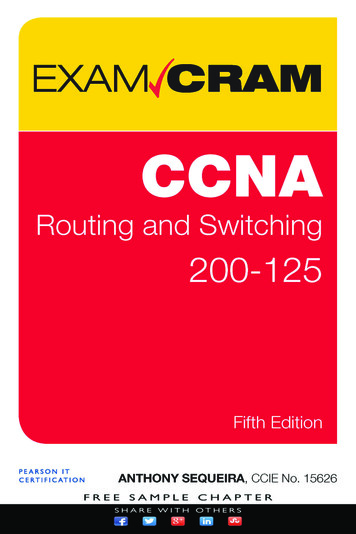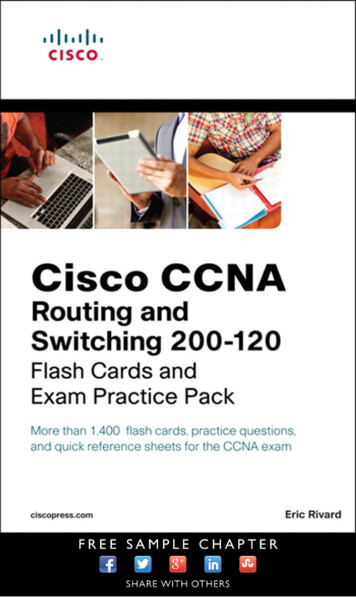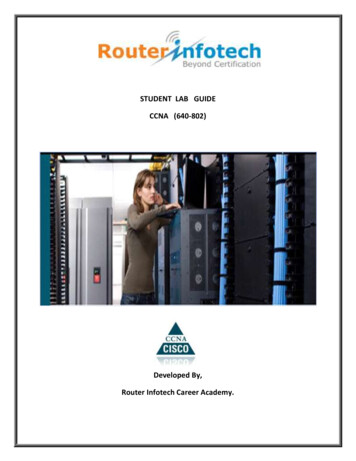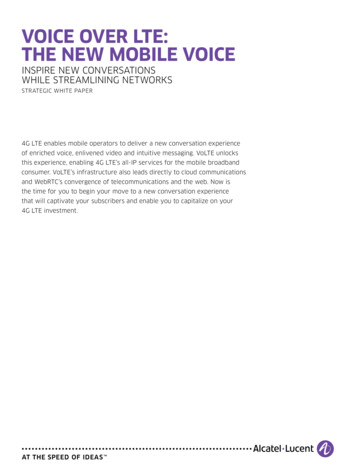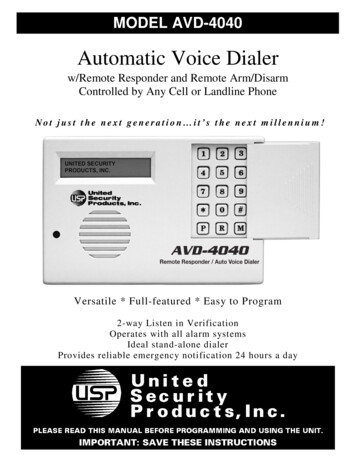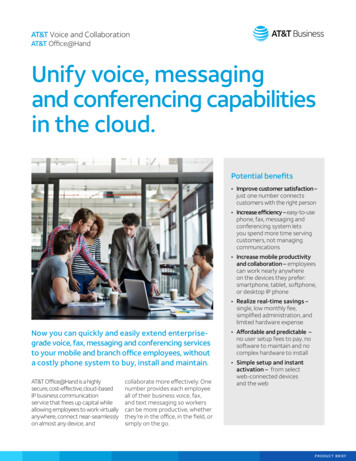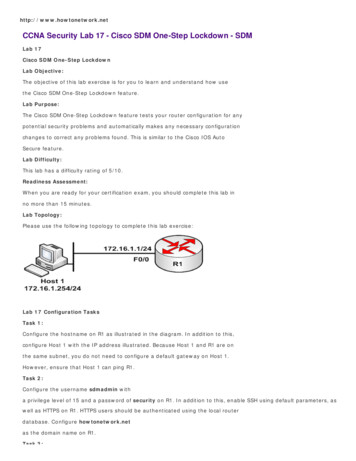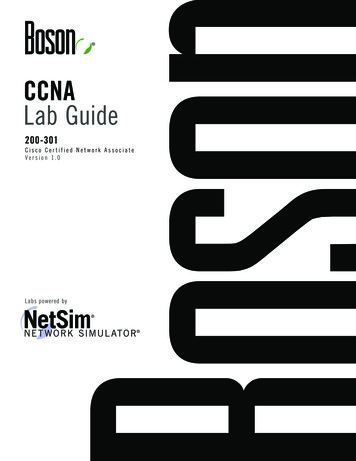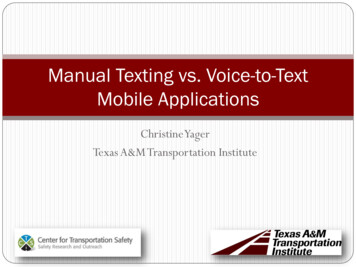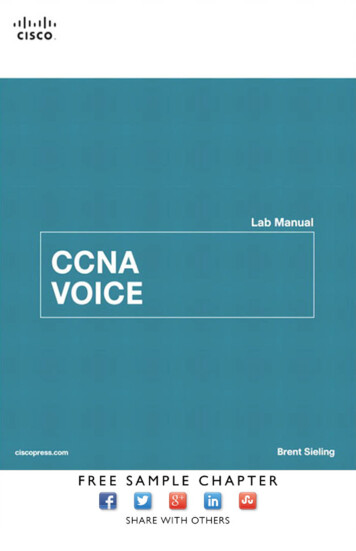
Transcription
CCNA Voice Lab ManualBrent SielingCisco Press800 East 96th StreetIndianapolis, Indiana 46240 USA
iiCCNA Voice Lab ManualCCNA Voice Lab ManualBrent SielingCopyright 2013 Cisco Systems, Inc.Published by:Cisco Press800 East 96th StreetIndianapolis, IN 46240 USAAll rights reserved. No part of this book may be reproduced or transmitted in anyform or by any means, electronic or mechanical, including photocopying, recording, or by any information storage and retrieval system, without written permissionfrom the publisher, except for the inclusion of brief quotations in a review.Printed in the United States of AmericaSecond Printing: February 2014Library of Congress Cataloging-in-Publication Data is on file.PublisherPaul BogerAssociate PublisherDave DusthimerBusiness Operation Manager,Cisco PressAnand SundaramExecutive EditorMary Beth RayManaging EditorSandra SchroederDevelopment EditorEllie BruProject EditorMandie FrankCopy EditorJohn EdwardsISBN-13: 978-1-58713-299-5ISBN-10: 1-58713-299-0Technical Editor(s)Brion WashingtonMichael H. ValentineWarning and DisclaimerEditorial AssistantVanessa EvansThis book is designed to provide information about CCNA Voice. Every effort hasbeen made to make this book as complete and as accurate as possible, but no warranty or fitness is implied.DesignerMark ShirarThe information is provided on an “as is” basis. The authors, Cisco Press, andCisco Systems, Inc. shall have neither liability nor responsibility to any person orentity with respect to any loss or damages arising from the information containedin this book or from the use of the discs or programs that may accompany it.ProofreaderSheri CainThe opinions expressed in this book belong to the author and are not necessarilythose of Cisco Systems, Inc.CompositionTricia Bronkella
iiiTrademark AcknowledgmentsAll terms mentioned in this book that are known to be trademarks or service marks have been appropriately capitalized. Cisco Press or Cisco Systems, Inc., cannot attest to the accuracy of this information. Use of a term in this book should not be regarded as affecting the validity of any trademark orservice mark.Corporate and Government SalesThe publisher offers excellent discounts on this book when ordered in quantity for bulk purchases orspecial sales, which may include electronic versions and/or custom covers and content particular toyour business, training goals, marketing focus, and branding interests. For more information, pleasecontact: U.S. Corporate and Government Sales 1-800-382-3419corpsales@pearsontechgroup.comFor sales outside the United States, please contact: International Salesinternational@pearsoned.comFeedback InformationAt Cisco Press, our goal is to create in-depth technical books of the highest quality and value. Eachbook is crafted with care and precision, undergoing rigorous development that involves the uniqueexpertise of members from the professional technical community.Readers’ feedback is a natural continuation of this process. If you have any comments regarding howwe could improve the quality of this book, or otherwise alter it to better suit your needs, you can contact us through email at feedback@ciscopress.com. Please make sure to include the book title andISBN in your message.We greatly appreciate your assistance.CiscoAmericas HeadquartersCisco Systems, inc.170 West Tasmars DriveSan Jose, CA 95134-1706USAwww.cisco.comTel: 408 526-40008QO 553-NETS (8387)Fax: 408 527-G883Asia Pacific HeadquartersCisco Systems, Inc.188 Robinson Road#28-01 Capital TowerSingapore 068912www.cisco.comTel :* 65 6317 7777Fax: 63 6317 7789Europe HeadquartersCisco Systems international BVHaarlerbergparkHaarlerbergweg 13-191101 CH AmsterdamThe Netherlandswww-europe.cisco.eomTel: - 31 0800 020 0791Fax: - 31 020 357 1100Cisco has more than 200 offices worldwide. Addresses, phone numbers, and fax numbers are listed on the Cisco Website at www.cisco.com/go/offices. 20088Cisco Systems, Inc. All rights reserved. CCVR the Cisco logo, end the Cisco Square Bridge logo are trademarks of Cisco Systems, Inc.; Changing the Way We Work. Live, Play, snd Learn is a service mark of CiscoSystems, Inc.; and Access Registrar Aironet, BPX, Catalyst, CCDA, CCDR CCIE, CCIR CCNA, CGNR CCSR Cisco, the Cisco Certified Internetwork Expert logo, Cisco IOS, Cisco Press, Cisco Systems, Cisco Systems Capitthe Cisco Systems logo, Cisco Unity, Enterprise/Solver, EtherChannel, EtherFast, EherSwitch, Fast Step. Follow Me Browsing. FormShare, GigaDrive, GigsStack, HomeLJnk. Internet Quotient. IOS, IP/TV iQ Expertise, the iQ logo,iQ Net Readiness Scorecard. (Quick Study. LightStream. Linksys, MeetingPlace. MGX, Networking Academy, Network Registrar Packet. FIX. ProGonnect RateMUX. ScriptShare, SfideCast, SMARTnet, StackWIse, The FastestWay to Increase Your internet Quotient, and TransPath are registered trademarks of Cisco Systems, Inc. and/or its affiliates in the United States and certain other countries.All other trademarks mentioned in this document or Website are the property of their respective owners. The use of the word partner does not imply a partnership relationship between Cisco and any other company. JQ6G9R)
ivCCNA Voice Lab ManualAbout the AuthorBrent Sieling is an instructor and program director for the two-year Network Specialist AssociateDegree at Madison College. He has been teaching networking classes full-time since January 2006and part-time for three semesters prior to that. He is the lead contact for the Academy Support Centerand Instructor Training Center at Madison College’s Cisco Networking Academy, providing support toover 30 high schools and technical colleges in the state of Wisconsin. Brent previously worked as anetwork specialist at the Madison Metropolitan School District, where he managed a network of over50 schools. Brent currently holds the Cisco Certified Network Associate (CCNA), CCNA Voice, andCCNA Security certifications, and he was previously a Certified Novell Engineer (CNE). He recentlycompleted the Cisco Academy Instructor Trainer Qualification (ITQ) process to become an AcademyInstructor Trainer. Brent has been a regular presenter at the Cisco Academy conferences.About the Contributing AuthorsDavid Bateman is a Certified Cisco Systems instructor with more than 20 years of internetworkingexperience. David has always enjoyed sharing his knowledge and has been a Cisco instructor forSkyline-ATS since 2000. In addition to teaching he is involved in authoring courses and books including Configuring Cisco Communication Manager & Unity Connection released by Cisco Press. Davidis currently the director of Educational Services for Skyline-ATS. His years of real-world technicaland business knowledge allow him to bring a unique perspective to the classroom, where he not onlydelivers critical technical knowledge but can also explain how technologies can be used to addressvarious business needs.Brian Morgan, CCIE No. 4865, is a Collaboration Architect with Cisco specializing in UnifiedCommunications and Collaboration technologies. With over 20 years in the networking industry, hehas performed in a number of roles, including network consultant, Certified Cisco Systems Instructor,and engineering director for a telecommunications company. When he’s not spending time with hisfamily, Brian enjoys working with local high school and college students enrolled in local CiscoNetwork Academy programs in North Texas.
vAbout the Technical ReviewersMichael Valentine has more than 15 years of experience in the IT field, specializing in Cisco networking and VoIP technologies. He is a freelance Cisco Certified Systems Instructor, currently associated with Skyline Advanced Technology Services. His accessible, humorous and effective teachingstyle has demystified Cisco for hundreds of students since he began teaching in 2002. He has developed courseware and lab guides both for Cisco Systems and third-party clients.Mike received his Bachelor of Arts from the University of British Columbia and currently holdsCCNA, CCNA Voice, CCDA, CCNP, CCVP, and CCSI certifications, among others.Mike has authored, co-authored, and technically reviewed several Cisco Press titles.Brion Washington has been working with Cisco VOIP since the 4.x release. His expertise is in CiscoUnified Communications Manager (CUCM) and Voice Gateways. He has authored the CCVP GWGKQuick Reference (978-1-58714-355-7), CCNP Voice TVoice 642-427 Quick Reference (978-1-58714365-6), and CCNP Voice CAPPS 642-467 Quick Reference (978-1-58714-361-8), and served as atechnical editor for multiple others. He currently works as a Senior Network Engineer based on theEast coast.
viCCNA Voice Lab ManualAcknowledgmentsI have many people to thank for helping put this book together. Thankfully for me, this is not theAcademy Awards, where the orchestra can cut me off if I go on too long.First is Mary Beth Ray of Cisco Press. I owe her thanks for her willingness to work with a first-timeauthor to produce a lab book for the CCNA Voice certification. I owe her even more thanks for notsending the Cisco Press Ninja Assassins after me when I was late on my deadlines, even though Icompletely deserved it.To Ellie Bru, Mandie Frank, and John Edwards of Cisco Press. Ellie and Mandie had the unfortunatetask of working with a first-time author, trying to get me to complete everything (and in a readableformat). John not only had to correct my writing, but also to translate it into proper English.To David Bateman and Brian Morgan. Despite my years of experience with Cisco’s router-based voicesolution, there are parts of the voice world, such as Cisco Unified Presence Server, that I had not dabbled in. Their writing both helped to make this book more complete and kept the deadlines from slipping any further.To Brion Washington and Michael Valentine. As technical reviewers, they both made sure that I wasas accurate as possible in explanations, and more than once caught areas where I made mistakes.To David Shonkwiler and Ken McCullough. As my dean and department head, respectively, they havemade it possible to teach in one of the finest two-year schools in the state of Wisconsin, if not thenation. They have made sure that my students have access to the equipment and resources in the classroom to succeed in their future jobs.To Cheryl Halle and Curt Chambers. As any instructor will tell you, his or her success is in large partdue to the people who provide help, and Cheryl and Curt are the best at running our labs. The labs areso well run that the Cisco Academy has held instructor training qualifications here twice in the pastyear, and the Academy told us it could not have had an easier time.There are many students who were guinea pigs for my labs over the past year and worked on my betaversions (and many alpha versions). They had to put up with my hands waving in the air as Iexplained how cool this stuff was, even the QoS portion. I was able to sneak their names intoAppendix B, “IP Addressing and Phone Extensions for Cisco Unified Communications Manager Labs(Chapters 8–14 and 16–17),” along with many of my students who achieved their CCNA certificationwhile at Madison College. However, there are two students who went above and beyond and deservespecial recognition: Krzysztof Petrynko and John Endries. They both put in numerous hours checkingmy labs and giving me valuable feedback.In addition to dedicating the book to my wife Megan, I also have to thank her for not only keepingthings running at home (I promise to start cooking dinner more often now that this is done!), but alsofor doing the initial proofread of all my writing. (She was the one to point out that I needed tohyphenate ever-patient in the dedication.)Finally, I have to thank Cisco itself and, by extension, the Cisco Networking Academy. There are fewcompanies in the world that would spend millions of dollars to develop and maintain excellent curriculums and then give it to schools at no cost. My former students would not have their great jobswithout the fantastic CCNA Exploration curriculum that the Academy offers. I have found great success in teaching the Academy curriculum and learned many new things along the way.
viiDedicationThis book is dedicated to my ever-patient wife Megan Schliesman and my wonderful daughter Lily(who will be mortified that I mentioned her name).
viiiCCNA Voice Lab ManualContents at a GlanceIntroduction xxviiiHardware Section xxixPart I:Voice ConceptsChapter 1Traditional and Unified VoiceChapter 2Understanding Cisco Unified Communications SolutionsChapter 3Establishing Network Connectivity and Understanding IP Phone RegistrationPart II:Cisco Unified Communications Manager Express (CUCME)Chapter 4Introduction to CUCME AdministrationChapter 5Configuring Phones and Users in Cisco Unified Communications ManagerExpress (CUCME) 37Chapter 6Cisco Unified Communications Manager Express (CUCME) Dial Plans and QoSChapter 7Cisco Unified Communications Manager Express (CUCME) ProductivityFeatures 151Part III:Cisco Unified Communications Manager (CUCM)Chapter 8Administrative InterfacesChapter 9Managing Services, Phones, and UsersChapter 10 CUCM Dial Plan32373169257Chapter 12 CUCM Mobility Features337363Voicemail and Presence SolutionsChapter 13 Cisco Unity Connection381Chapter 14 Cisco Unified Presence425Part V:Management and TroubleshootingChapter 15Troubleshooting Cisco Unified Communications Manager Express (CUCME)Chapter 16 Troubleshooting CUCM457465Chapter 17 Monitoring Cisco Unity ConnectionPart VI:5165Chapter 11 CUCM Telephony FeaturesPart IV:1481AppendixesAppendix A IP Addressing and Phone Extensions for Cisco Unified CommunicationsManager Express (CUCME) Labs 489Appendix B IP Addressing and Phone Extensions for Cisco Unified CommunicationsManager (CUCM) Labs (Chapters 8–14 and 16–17) 495Appendix C Building Cisco Unified Communications Manager (CUCM), Cisco UnityConnection (CUC), and Cisco Unified Presence (CUPS) Servers in VMwareWorkstation 501Appendix D Configuring the Cisco Unified Communications Manager Express RouterAppendix E PSTN Simulator547531
ixContentsIntroductionxxviiHardware SectionxxixPart I: Voice ConceptsChapter 1Traditional and Unified VoiceLab 1-1: Telephony Terminology11Task 1: Matching Items 1Chapter 2Understanding Cisco Unified Communications Solutions3Lab 2-1: Key Features of Cisco Unified Communications Solutions3Task 1: Questions 3Chapter 3Establishing Network Connectivity and Understanding IP PhoneRegistration 5Lab 3-1: Network Connectivity5Task 1: Clear and Cable Devices 6Step 1-1: Clear Prior Configurations 6Step 1-2: Cable Router and Switch 6Task 2: Configure Basic Setup 6Step 2-1: Configure Basic Setup on the Router 6Step 2-2: Configure Basic Setup on the Switch 6Task 3: Configure the Switch 7Step 3-1: Create the VLANs 7Step 3-2: Configure the Trunk Port 7Step 3-3: Configure the Access Ports 8Step 3-4: Configure the Switch Management Interface 9Task 4: Configure the Router Subinterfaces 9Step 4-1: Configure the Data VLAN Subinterface 9Step 4-2: Configure the Management VLAN Subinterface 9Step 4-3: Configure the Voice VLAN Subinterface 9Step 4-4: Activate the Router Interface 9Task 5: Verification 10Step 5-1: Verify Switch VLAN Configuration 10Step 5-2: Verify Switch Port Assignment 10Step 5-3: Verify Router Subinterface IP Assignment 11Task 6: DHCP Services 11Step 6-1: Configure DHCP Pools on the Router 12Task 7: Test and Cleanup 12Step 7-1: Test Connectivity 12Step 7-2: Save the Configurations 12Step 7-3: (Optional) Explore Power Over Ethernet on the Switch 13
xCCNA Voice Lab ManualLab 3-2: Network Time Protocol15Task 1: NTP Services 15Step 1-1: Load Prior Configurations 15Step 1-2: (Optional) Configure Local Time Zone 16Step 1-3: Manually Set the Clock 16Step 1-4 (Option A): Contact an NTP Server on the Internet 16Step 1-4 (Option B): Configure Another Cisco Router to Act as an NTPServer 17Step 1-5: Verify That the Time Is Synchronized 17Step 1-6: (Optional) Configure the Switch to Get NTP from the Router 21Step 1-7: Save the Configurations 21Lab 3-3: Phone Boot/Registration Process22Task 1: Questions 22Part II: Cisco Unified Communications Manager Express (CUCME)Chapter 4Introduction to CUCME Administration23Lab 4-1: Exploring the Command-Line Interface and Cisco ConfigurationProfessional 23Task 1: Load Prior Configurations 23Task 2: Explore Telephony Services 24Step 2-1: Determine CUCME Version 24Task 3: Exploring CUCME Using CCP 25Step 3-1: Test Connectivity Between PC and Router 25Step 3-2: Configure the Router for CCP Access 25Step 3-3: Open the CCP Application 26Step 3-4: Create a Community in CCP 26Step 3-5: Working with a Community in CCP 27Step 3-6: Viewing Device Configuration Options in CCP 28Step 3-7: Establish Unified Communication Functionality in CCP 29Step 3-8: Deliver Configuration from CCP to the Router 29Step 3-9: Review Unified Communications Features Summary 30Step 3-10: Save the Startup Configuration in CCP 31Step 3-11: Save the Running Configuration to the PC Using CCP 31Step 3-12: Explore Other Parts of CCP 32Lab 4-2: Integrated HTML GUI33Task 1: Load Prior Configurations 33Task 2: Configure the Router for Web Access 33Step 2-1: Enable HTTP Service on the Router 33Step 2-2: Create a CUCME Web Administrator Account 34Step 2-3: Use a Web Browser to Connect to the GUI 34Chapter 5Configuring Phones and Users in Cisco Unified CommunicationsManager Express (CUCME) 37Lab 5-1: Basic Manual Phone Configuration Using the CLI37Task 1: Load Prior Configurations 38Task 2: Configure Telephony-Service 38Step 2-1: Disable Auto Phone Registration 38Step 2-2: Establish the Maximum Number of Phones Allowed to Register 38Step 2-3: Establish the Maximum Number of Directory Numbers (PhoneNumbers) 38
xiStep 2-4: Set the IP Address Used by CUCME 39Step 2-5: Create the Default Template Files 39Step 2-6: Inspect the IP Phone Generic Config File 40Task 3: Configuring Directory Numbers 41Step 3-1: Create a Dual-Line Ephone-dn 41Step 3-2: Repeat to Create the Next Three Phone Numbers 41Task 4: Manually Configure an Ephone and Associate the First DirectoryNumber 42Step 4-1: Get the MAC Address of the First Phone 42Step 4-2: Create an Ephone and Assign the MAC Address 42Step 4-3: Assign the First Directory Number to the First Button on the Phone43Step 4-4: Connect the First Phone to the Switch 44Task 5: Manually Configure a Second Phone 44Step 5-1: Connect the Second Phone to the Switch 45Step 5-2: Assign the Second and First Directory Numbers to the SecondPhone 45Step 5-3: Make a Call 46Step 5-4: Assign Other Extensions to the First Phone 46Step 5-5: Clear Configuration for the Next Lab 47Lab 5-2: Advanced Manual Phone Configuration Using the CLI48Task 1: Load Prior Configurations 48Task 2: Configure Telephony-Service 49Step 2-1: Configure Required Telephony-Service Settings 49Step 2-2: Configure System Time in Telephony-Service 49Step 2-3: Configure a Banner Message for Phones with a Display 49Task 3: Configure Ephone-dns 50Step 3-1: Add the name Option to an Ephone-dn 50Step 3-2: Change the Phone Display Header Bar 50Step 3-3: Change the Text for Each Line Button 51Step 3-4: Create the Other Ephone-dns 51Task 4: Configure Ephones 51Step 4-1: Create an Ephone, and Assign the MAC Address and a DirectoryNumber 51Step 4-2: Assign the Ephone Model Type 52Step 4-3: Assign Users to the Phones 52Step 4-4: Create the Other Ephones 52Task 5: Test and Save Configuration 53Step 5-1: Make Calls 53Step 5-2: Save the Configuration 53Lab 5-3: Adding Directory Numbers, Phones, and Users with CiscoConfiguration Professional (CCP) 54Task 1: Load Prior Configurations 54Task 2: Configure Telephony Settings 55Step 2-1: View Telephony Settings 55Step 2-2: Edit General Telephony Settings 55Step 2-3: Edit System Config Telephony Settings 56Task 3: Configure Extensions 57Step 3-1: View Extension Settings 57Step 3-2: Create an Extension 58Step 3-3: Create More Extensions 60
xiiCCNA Voice Lab
working and VoIP technologies. He is a freelance Cisco Certified Systems Instructor, currently associ-ated with Skyline Advanced Technology Services. His accessible, humorous and effective teaching style has demystified Cisco for hundreds of students since he began teaching in 2002. He ha
